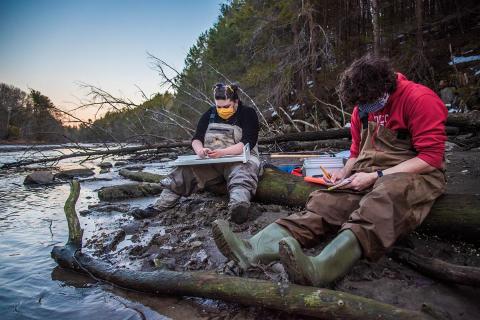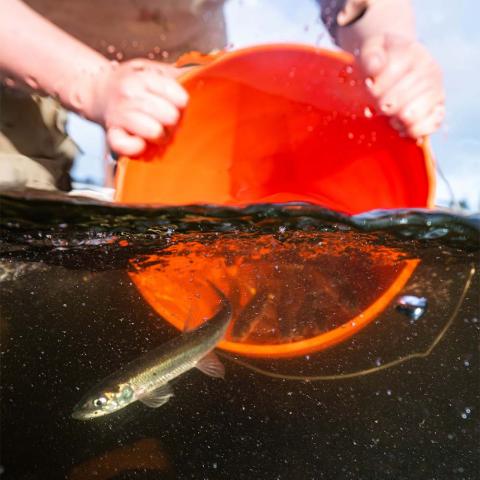
What is Smelt Monitoring?
Every spring, rainbow smelt spawn in the rivers and estuaries surrounding Great Bay. Unfortunately, populations of rainbow smelt, a native species important to ice fishing, have declined in New Hampshire and are listed as a Species of Concern by state and federal agencies. Estuaries are presumed to serve as important ecosystems for rainbow smelt because smelt travel between fresh and saltwater habitats, but the role estuaries play in smelt populations is not well understood. With of the help of citizen scientists, this research will help future managers better protect and enhance populations of rainbow smelt and revive a threatened ice fishery.
What do Smelt Monitoring Volunteers do?
Coastal Research Volunteers monitor migrating rainbow smelt in three of Great Bay’s tributaries: the Oyster, Squamscott, and Winnicut Rivers. Monitoring occurs Tuesday through Thursday for the duration of the smelt migration, typically March (as soon as the ice melts) through April. After attending a training session, volunteers can sign up online for smelt monitoring shifts. A typical shift consists of two or three volunteers working together with NH Fish and Game and UNH scientists to remove smelt from the instream net where they’ve been captured since the previous monitoring shift. Volunteers count and measure length and mass of each smelt. Volunteers also record various other data, determining age (scales), sex, river, and Passive Integrated Transponder or PIT tag number, for each rainbow smelt captured. After PIT tag insertion and data collection, rainbow smelt are monitored in a separate container and released back into the river.
Trained smelt monitoring volunteers can sign up to fill daily smelt monitoring shifts. A typical shift lasts 1-3 hours Tuesday-Thursday, and volunteers can sign up for as many or as few shifts as they’d like. Shifts are posted the Friday before each week, and times vary due to logistics with staff, tides, and weather. Flexibility is important!
Data from the rainbow smelt monitoring program go directly to New Hampshire Fish and Game Department for management purposes. The project aims to provide information on the relative success of former management actions (such as stock enhancement), migration patterns (including the use of multiple rivers), and annual survival rates of adult rainbow smelt that spawn in Great Bay tributaries.
Interest in river-based field experiences, handling rainbow smelt, and data recording!
*Access to the banks of rivers can be challenging. Conditions may be slippery, steep, or rocky.
- Meet people from your community with similar interests
- Feel more connected and knowledgeable about your watershed
- Opportunity to handle and learn about a fascinating fish in New Hampshire's rivers and estuaries
- Contribute useful information to a long-term dataset used to improve management of the rainbow smelt population

Join our rainbow smelt monitoring effort!
Do you love New Hampshire's rivers and estuaries? Do you want to learn more about the role estuaries play in rainbow smelt populations, or get to know others in the community who are just as motivated to care for our watershed?
Please contact Wells for more information on how to become involved.
Links, resources, and partner organizations
Want to learn more? Read this interactive story about Sea Grant research into the life cycles, behaviors, and restoration of Sea Run fish around New England, including this project with Dr. Nathan Furey from UNH.
Read the NH Fish and Game Rainbow Smelt profile.
Read about Dr. Furey's research project funded by Sea Grant.
